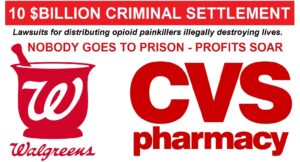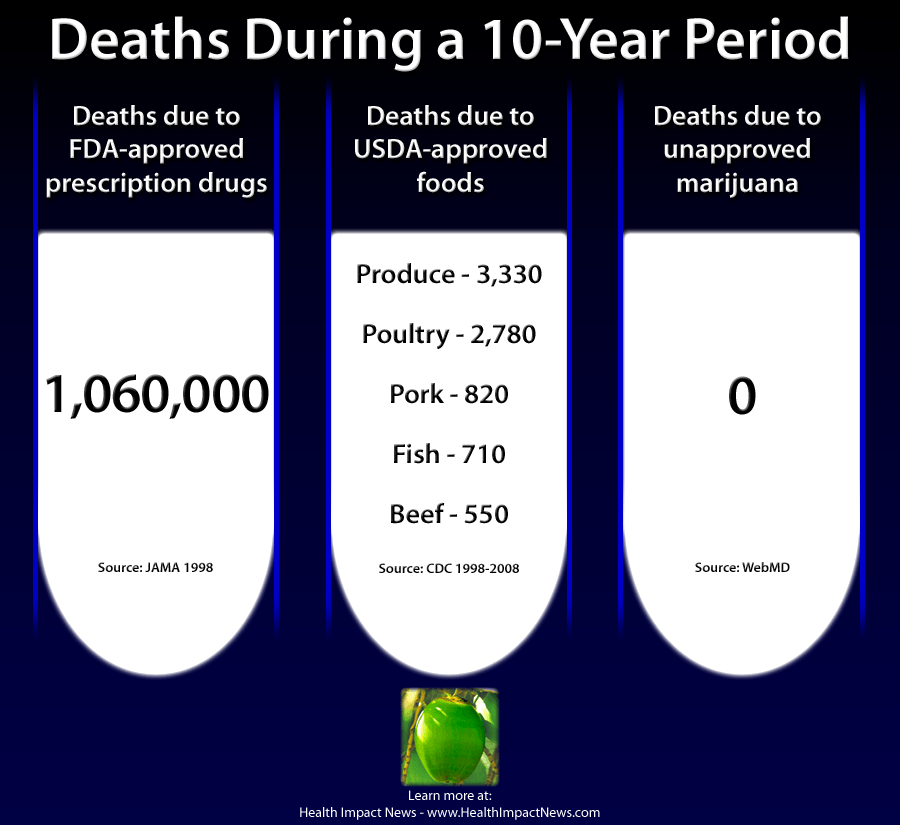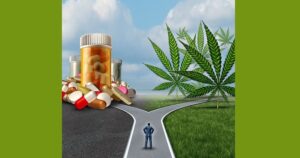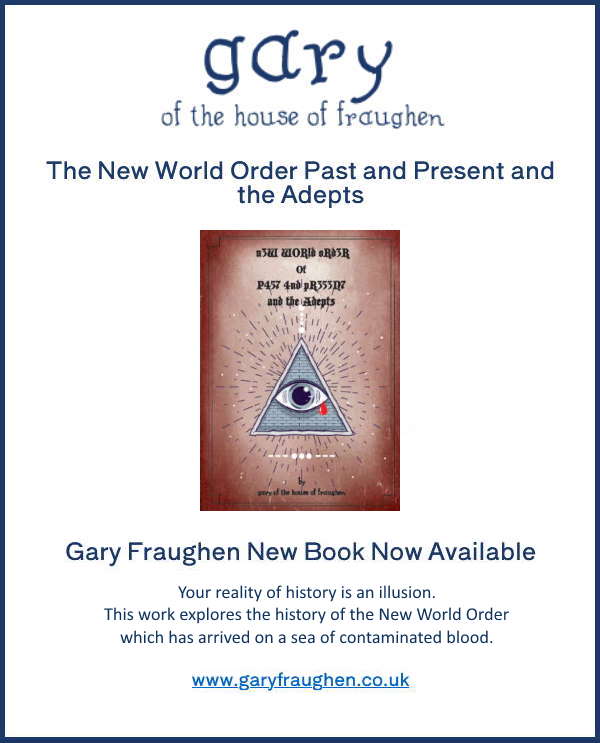America’s Biggest Criminal Drug Dealers Go Free and Continue to Push Their Drugs that Destroy Lives
Tue 8:26 am +00:00, 22 Nov 2022
by Brian Shilhavy
Editor, Health Impact News
Two of America’s largest criminal drug dealers recently reached a $10 billion settlement for their role in America’s opioid crisis that has cost tens of thousands of deaths and countless lives destroyed for the past several years.
CVS and Walgreens tentatively agreed to pay a combined $10 billion to resolve lawsuits brought by states and local governments alleging the retailers mishandled prescriptions of opioid painkillers.
U.S. states, cities and counties have filed more than 3,000 lawsuits against opioid manufacturers, distributors and pharmacies, accusing them of downplaying the addiction risk and failing to stop pills from being diverted for illegal use. (Source.)
As part of this settlement, nobody goes to prison, and these drug dealers get to keep pushing their harmful drugs. They even get to spread out their criminal payments over several years so they don’t suffer any business loss.
It will pay approximately $5 billion over the next 10 years beginning in 2023, according to CVS’ press release. The drugstore chain will pay $4.9 billion to states and political subdivisions and $130 million to resolve opioid claims brought by Native American tribes.
The financial resolution is designed to “substantially resolve all opioid lawsuits and claims against the company by states, political subdivisions, such as counties and cities, and tribes,” CVS said in the release.
Walgreens, in a filing with the U.S. Securities and Exchange Commission on Wednesday, said it would provide approximately $4.79 billion in remediation payments to be made over 15 years, including about $154 million for participating tribes and more than $750 million in legal fees. (Source.)
CVS reported a quarterly loss of more than $3 billion to cover its share of a global opioid settlement, but its third-quarter earnings blew past Wall Street estimates. (Source.)
The CDC had originally issued stricter guidelines for prescribing opioids in an effort to reduce illegal use and addictions, but a couple of weeks ago they backtracked on those guidelines making it easier for doctors to continue prescribing opioids. (Source.)
Pharmaceutical Prescription Drugs Kill Far More People than Illegal Street Drugs

Deaths resulting from prescription pharmaceutical drugs far exceed deaths due to illegal street drugs, and it is not even close.
The “war on drugs” started during the 1970s has created several generations now of mind-controlled drug users who incorrectly believe that illegal drugs are dangerous, while their prescription drugs are safe.
The most commonly used “illegal drug” used by millions of Americans today is cannabis, or marijuana. While it remains a felony to possess or use marijuana at the federal level, it is now legal to use at the state level for 74% of the U.S. population as of the last 2022 mid-term elections. (Source.)
While cannabis use has increased in the U.S. for both recreational and medical reasons, the pharma-funded corporate media continues to demonize it, and for good reason. Marijuana is best known for its recreational use, but if you can bypass the corporate censorship that obviously sees marijuana as a threat to patented pharmaceutical drugs, you will learn that the therapeutic benefits to marijuana are absolutely amazing.
And as a natural herb, it is one of the safest drugs to use. The most common side effects of “overdosing” on marijuana are falling asleep, and eating too much (it creates the “munchies”).
The safety of marijuana has been widely documented, but in today’s censorship atmosphere with the search engines, you are not likely to find this research and only find negative information regarding marijuana if you use an Internet search engine, and that includes privacy-based search engines such as duckduckgo.com that gets most of their results from Microsoft’s Bing.

In 2005, ProCon.org sent a Freedom of Information Act (FOIA) request to the US Food and Drug Administration (FDA) to find the number of deaths caused by marijuana compared to the number of deaths caused by 17 FDA-approved drugs. What they discovered was that marijuana has no cases of directly causing any deaths, only “secondary causes contributing to death,” which could be something like being too high to drive and getting into an automobile accident.
I had to go to archive.org to dig this up, but ProCon.org’s Freedom of Information Act (FOIA) request to the US Food and Drug Administration (FDA) in 2005 looked at the number of deaths caused by marijuana compared to FDA-approved drugs.
They stated that twelve of these FDA-approved drugs were chosen because they are commonly prescribed in place of medical marijuana, while the remaining five FDA-approved drugs were randomly selected because they are widely used and recognized by the general public. (Source.)
They summarized the data they collected from the FDA in the following tables:
IV. Summary of Deaths by Drug Classification
DRUG CLASSIFICATION Specific
Drugs per
CategoryPrimary
Suspect of the DeathSecondary Suspect (Contributing to death) Total Deaths Reported
1/1/97 – 6/30/05A. MARIJUANA
also known as: Cannabis sativa LMarijuana
Cannabis
Cannabinoids0 279 279 B. ANTI-EMETICS
(used to treat vomiting)Compazine
Reglan
Marinol
Zofran
Anzemet
Kytril
Tigan196 429 625 C. ANTI-SPASMODICS
(used to treat muscle spasms)Baclofen
Zanaflex118 56 174 D. ANTI-PSYCHOTICS
(used to treat psychosis)Haldol
Lithium
Neurontin1,593 702 2,295 E. OTHER POPULAR DRUGS
(used to treat various conditions including ADD, depression, narcolepsy, erectile dysfunction, and pain)Ritalin
Wellbutrin
Adderall
Viagra
Vioxx*8,101 492 8,593 F. TOTALS of A-E Number
of Drugs
in TotalPrimary
Suspect of the DeathSecondary Suspect
(Contributing to death)Total Deaths Reported
1/1/97 – 6/30/05TOTAL DEATHS FROM MARIJUANA 1 0 279 279 TOTAL DEATHS FROM 17 FDA-APPROVED DRUGS 17 10,008 1,679 11,687
V. Chart of Deaths from Marijuana and 17 FDA-Approved Drugs
F. TOTALS of A-E Primary Suspect Secondary Suspect
(Contributing to death)Total Deaths Reported
1/1/97 – 6/30/05TOTAL DEATHS FROM MARIJUANA 0 279 279 TOTAL DEATHS FROM 17 FDA-APPROVED DRUGS 10,008 1,679 11,687
In 2003, WebMD published an article titled: “Marijuana Smoking Doesn’t Kill.”
Marijuana smoking isn’t harmless, but at least it won’t kill you.
It’s been feared that marijuana smoke, like tobacco smoke, causes cancer and heart disease. The evidence argues otherwise, writes Stephen Sidney, MD, associate director for research for Kaiser Permanente, Oakland, Calif., in the Sept 20 issue of The British Medical Journal.
“Although the use of [marijuana] is not harmless, the current knowledge base does not support the assertion that it has any notable adverse public health impact in relation to mortality,” Sidney concludes.
No Marijuana Deaths in 2 Large Studies
Sidney points to two large studies. The first is from (where else?) California. A large HMO looked at 65,177 men and women age 15-49. Over 10 years, marijuana users died no sooner than nonusers.
The second study looked at 45,450 Swedish army conscripts. They were 18-20 years old when asked about marijuana use. Fifteen years later, the marijuana users were just as likely to remain alive as nonusers.
And since marijuana smoking can’t kill outright — there’s no such thing as a fatal marijuana overdose… (Full article.)
While the statistics show marijuana is not fatal, the corporate media still does its best to demonize it. A recently published article that many even within the Right Wing Alternative Media highlighted suggested that smoking marijuana contributed to lung disease.
But as always, you have to examine the study for yourself to see what the data in that study actually stated. Here is what the corporate media published on the study:
Smoking weed while being a tobacco smoker may increase damage to the respiratory system, a new study found.
“There’s a public perception that marijuana is safer than tobacco, and this study raises concern this may not be true,” said lead study author Dr. Giselle Revah, an assistant professor in the department of radiology at the University of Ottawa in Ontario.
“The American Lung Association says the only thing that should go into your lungs is clean air, so if you’re inhaling anything, it could potentially be toxic to your lungs,” she said.
Small, preliminary study
The preliminary study, published Tuesday in Radiology, a journal of the Radiological Society of North America, compared computed tomography (CT) chest scans from 56 people who smoked marijuana and tobacco with lung scans of 33 people who had been heavy cigarette smokers for over 25 years.
Scans from an additional 57 nonsmokers with no preexisting lung disease, chemotherapy or other history of lung damage were used as controls.
Some 75% of the people in the study who smoked marijuana and tobacco had emphysema, a disease of the small airways that causes damage to the air sacs in the lungs. About 67% of the tobacco-only smokers had emphysema, while only 5% of the nonsmokers had the disease, she said.
A difference of 8 percentage points between weed plus tobacco and tobacco-only smokers may not seem like a huge difference, but it was significant, Revah said.
“It suggests that marijuana has additional effects on the lungs than tobacco alone,” Revah said. “Is it the combination of the marijuana and tobacco that makes more holes in the lungs and airway inflammation or just the marijuana itself?” (Full article.)
So without even examining the actual study, and just reading what the corporate media published, does this study prove that smoking marijuana leads to lung disease?
No, it cannot make that conclusion, because people who only smoke marijuana and do not smoke tobacco, were not even included in this study!
Not only does this study NOT prove that smoking marijuana harms one’s lungs, there is plenty of evidence that marijuana can be used to treat lung diseases.
One of the pioneers who helped forge medical marijuana legislation in Oregon, Dr. Phil Leveque, who passed away in 2015 at the age of 90, has prescribed cannabis for over 5,000 patients and stated:
“Marijuana is one of the best bronchodilators, much better than any other class of drugs. For these respiratory diseases, [asthma and COPD] marijuana can be life-saving.”
Dr. Leveque also claimed that smoking marijuana was not bad for the lungs, claiming cannabinoids are beneficial for lung tissues.
One of the people who apparently came across Dr. Leveque’s research was Florida Judge Doug Bench’s wife, who began searching for alternative treatments when her husband was diagnosed with late stage chronic obstructive pulmonary disease (COPD) and only given 20 to 30 months to live.
She wanted her husband to try it, but there was one problem. As a judge, Doug Bench had sent 311 people to jail for marijuana possession and use. It was also illegal in Florida at the time.
But basically having nothing to lose, he started using it, and ended up having a full recovery. He is a strong advocate for medical marijuana today. Here is a 3-minute speech he gave in 2017 to the Florida Department of Health. This is on our Bitchute channel.
Judge Bench is very fortunate that his wife’s search of the Internet back then revealed the research on marijuana and lung disease, because that same search today would only turn up negative studies, such as the one I referenced above that just came out recently.
Fortunately, a search for “cannabis” on Health Impact News will return 156 results, and “marijuana” will return 201 results. You may not find these articles using Internet searches though.
One of the other common myths regularly blamed on marijuana, is that its use can be a “gateway” to more dangerous drugs.
However, since so many states have now legalized marijuana even for recreational use, the statistics actually show the opposite. In those states where marijuana has been legalized, opioid use has actually decreased. And some doctors are actually using medical marijuana to get people off of deadly opioids.
Opioid Pain Killer Drug Addictions Can Be Cured With Cannabis
Dr. Oz Looks at Medical Marijuana as a Potential Cure for Opioid Addiction
How Cannabis Can Be Used for Safe and Effective Opioid Drug Withdrawal
Marijuana Decreases Death Rates From Pain Killers By Over 30 Percent
I clearly remember the first time I had a kidney stone attack in the early 2000s. It required an expensive trip to the emergency room (I did not have health insurance) because the pain was so bad.
I was prescribed an opioid for the pain, vicodin, which would relieve the pain, relaxing my body, and allow the stone to move closer to my bladder where it would eventually come out.
So the next time I had a kidney stone attack, instead of going to the ER I asked a holistic doctor I knew to prescribe me the same opioid, and I was able to manage it passing without further medical intervention. I never used up using the entire prescription of vicodin, as I knew how addictive they were.
But as I researched opioids and their side effects, and the fact that vicodin also contained acetaminophen, which is toxic to the liver and has other negative side effects, I began looking into cannabis products instead, and ended up getting a medical cannabis card from a doctor that allowed me to purchase cannabis products at a dispensary.
I was recommended a cannabis extract in a soft gel with 100 mg. of THC to get a similar effect as an opioid. The next time I had a kidney stone attack, I tried it, and while it took a bit longer to take effect, it worked just as well if not better than the opioid! And as I have reported here, opioids are dangerous and kill people, but nobody has died from marijuana products.
Over the years we have published many articles containing testimonies and research on how medical cannabis is saving lives. It is truly one of nature’s most powerful therapeutic herbs, so it is no wonder that Big Pharma wants to suppress it.
And yet at the same time Big Pharma is patenting synthetic versions of cannabis components that can be benefited from as a pharmaceutical drug.
Big Pharma Investing $BILLIONS in Patented Marijuana Drugs while the Natural Plant Remains Illegal to Millions of Americans
I certainly do not want to minimize the potential harm that any drug can cause with recreational use, including marijuana, but marijuana is far safer than prescription drugs, and far more beneficial as well. And as far as recreational use, it is far safer than legal alcohol use.
The true criminal drug pushers today are the Big Pharma drug pushers such as Walgreens and CVS, who get away with their criminal activities with no repercussions, while average Americans who use cannabis, and often for very legitimate medical purposes, are losing their children to Child Protection Services and being treated like criminals. And many of these parents are military veterans suffering from PTSD but know that psych drugs that the VA prescribes are dangerous and lead to record number of suicides, while cannabis does not.
Learn more about how people are healing diseases with marijuana.
Comment on this article at HealthImpactNews.com.
America’s Biggest Criminal Drug Dealers Go Free and Continue to Push Their Drugs that Destroy Lives













